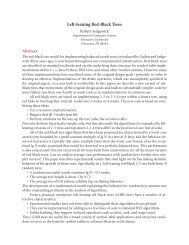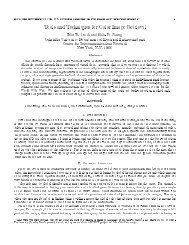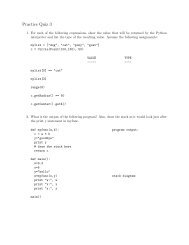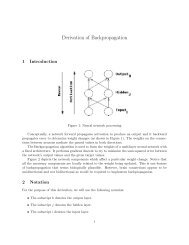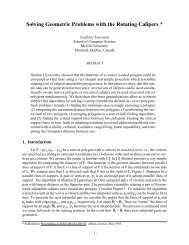Finding Musically Meaningful Words by Sparse CCA
Finding Musically Meaningful Words by Sparse CCA
Finding Musically Meaningful Words by Sparse CCA
Create successful ePaper yourself
Turn your PDF publications into a flip-book with our unique Google optimized e-Paper software.
vocab.sz. 488 249 203 149 103 50# CAL500 words 173 118 101 85 65 39# Web2131 words 315 131 102 64 38 11%Web2131 .64 .52 .50 .42 .36 .22Table 2: The fraction of noisy web-mined words in a vocabulary as vocabulary size is reduced:As the size shrinks sparse <strong>CCA</strong> prunes noisy words and the web-mined words are eliminated overhigher quality CAL500 words.4.2 Quantitative Results4.2.1 Vocabulary Pruning using <strong>Sparse</strong> <strong>CCA</strong><strong>Sparse</strong> <strong>CCA</strong> can be used to perform vocabulary selection where the goal is to prune noisy wordsfrom a large vocabulary. To test this hypothesis we combined the vocabularies from the CAL500and Web2131 data sets and consider the subset of 363 songs that are found in both data sets.Based on our own informal user study, we found that the Web2131 annotations are noisy when comparedto the CAL500 annotations. We showed subjects 10 words from each data set and asked themwhich set of words were relevant to a song. The Web2131 annotations were not much better thanselecting words randomly to from the vocabulary, whereas CAL500 words were mostly consideredrelevant.Because Web2131 was found to be noisier than CAL500, we expect sparse <strong>CCA</strong> to filter out moreof the Web2131 vocabulary. Table 2 shows the results of this experiment. In the experiment weselect a value for the sparsity parameter ρ and obtain a sparse vocabulary. Then we record howmany noisy Web2131 words comprise the resulting vocabulary. The first column in Table 2 reflectsthe vocabulary with no sparsity constraints. Because the starting vocabularies are of different sizes,Web2131 initially comprises .64 of the combined vocabulary size. Subsequent columns in the tableshow the resulting vocabulary sizes as we increase ρ and, consequently, reduce the vocabulary size.Noisy Web2131 words are being discarded <strong>by</strong> our vocabulary selection process at a faster rate thanthe cleaner CAL500 vocabulary, upholding our prediction that vocabulary selection <strong>by</strong> accousticcorrelation should tend to remove noisy words. The results imply that Web2131 contains morewords that are uncorrelated with the audio representation. The different ways that these data setswere collected reinforces this fact. Web2131 was mined from a collection of music reviews; thewords used in a music review are not explicitly chosen <strong>by</strong> the writer because they describe a song.This is the exact opposite condition under which the CAL500 data set was collected, in which humansubjects were specifically asked to label songs in a controlled environment.4.2.2 Vocabulary Selection for Music RetrievalIn this experiment we apply our vocabulary selection technique to a semantic music annotationand retrieval system. In brief, our system estimates the conditional probabilities of audio featurevectors given words in the vocabulary, P(song|word). These conditional probabilities are modeledas Gausian Mixture Models. With these probability distributions in hand, our system can annotate anovel song with words from its vocabulary, or it can retrieve an ordered list of (novel) songs basedbased on a keyword query. A full description of this system can be found in [17].One useful evaluation metric for this system is the area under the receiver operating characteristic(AROC) curve. (A ROC curve is a plot of the true positive rate as a function of the false positiverate as we move down a ranked list of songs given a keyword input.) For each word, its AROCranges between 0.5 for a random ranking and 1.0 for a perfect ranking. Average AROC is used todescribe the performance of our entire system and is found <strong>by</strong> averaging AROC over all words inthe vocabulary.This final performance metric is brought down <strong>by</strong> words that are difficult to model. These are wordsthat have a low AROC so they bring the average AROC down. We propose to use sparse <strong>CCA</strong>to discover these difficult words (prior to modeling). (Alternatively, one can say that we are usingsparse <strong>CCA</strong> to keep “easy” words that exhibit high correlation, as oppsed to discarding difficultwords.)6



